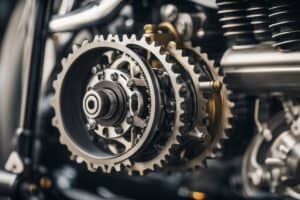Experiencing erratic idle speed can feel like your bike’s got a mind of its own, revving up or dropping RPMs without any input from you.
But don’t worry, you’re not alone in this; many riders face this issue, and there are ways to troubleshoot it.
Common Causes of Erratic Idle Speed
Erratic idle speed can be a frustrating issue for motorcycle enthusiasts.
Understanding the common causes is the first step to get your ride running smoothly.
- Fuel System Issues: Your motorcycle’s fuel system is often the culprit behind unstable idle speeds.
Debris or build-up in the carburetor can restrict fuel flow, leading to irregular performance.
Similarly, clogged fuel injectors in a fuel-injected motorcycle impede the precise delivery of fuel to the engine.
- Vacuum Leaks: An often-overlooked cause is vacuum leaks.
These occur when outside air enters the intake system of your bike, disrupting the air-fuel mixture.
Rubber hoses and gaskets age and can crack, leading to a leak that’s responsible for the erratic behavior.
- Ignition System Malfunctions: A weak spark or faulty ignition component can result in incomplete combustion.
This means your engine might sputter or vary in RPMs without any warning.
Regular checks on spark plugs, ignition wires, and coils are essential to prevent such issues.
- Idle Speed Adjustment: Sometimes, the fix is as simple as adjusting the idle speed screw.
However, this should be done cautiously, as improper adjustment can exacerbate the problem.
If you’re facing these issues, it’s crucial to perform a thorough inspection or consult a professional mechanic.
Regular maintenance and timely repairs can prevent erratic idle speed and ensure your motorcycle’s longevity and performance.
Remember, a well-tuned engine is the heartbeat of your ride’s smooth operation.
Checking the Fuel System
When you’re dealing with erratic idle speed, a key area to inspect is your motorcycle’s fuel system.
Dirt, debris, or blockages can significantly impact your bike’s performance.
Bear in mind that modern motorcycles have a more complex fuel injection system, whereas older models may use a carburetor setup.
Firstly, you’ll want to examine the fuel filter.
A clogged filter can restrict fuel flow, leading to erratic performance.
If it’s dirty, it’s time for a replacement.
Next, check the fuel lines for any signs of cracks or leaks that could affect pressure and flow.
For those with a carburetor, ensuring the jets are clean is pivotal.
Over time, residue can build up, narrowing the passageway and impeding the smooth flow of fuel.
A dose of carburetor cleaner or a session with compressed air can eliminate these obstructions.
In the case of fuel injection systems, the injectors themselves might be the culprits.
Similar to carburetor jets, fuel injectors can become fouled with deposits.
Injector cleaners or professional ultrasonic cleaning are excellent ways to restore proper function.
Also, be wary of the fuel pressure regulator; if it’s malfunctioning, fuel delivery will be erratic and can cause unstable idle.
Regularly inspecting and cleaning these components are essential steps in maintaining an optimal fuel system.
Keep up with these tips and your motorcycle is more likely to run smoothly, ensuring you get performance and reliability on every ride.
Inspecting the Air Filter
After addressing the fuel system, turn your attention to the air filter.
This crucial component ensures that your motorcycle’s engine receives clean air.
When it’s dirty or clogged, it can cause the engine to run erratically.
A healthy mix of air and fuel is essential for smooth operation.
Begin by locating your motorcycle’s air filter.
Typically, you’ll find it under the seat or within the airbox.
Consult your owner’s manual for the exact location and recommended inspection intervals.
Once you’ve identified it, proceed to assess its condition.
A visual inspection should reveal if the air filter is due for a replacement.
Look for signs of excessive dirt, grime, or damage.
If you can see light through the filter, it’s usually a good indicator that air can pass through as well.
If not, it’s time for it to be cleaned or replaced.
Here are steps to maintain your air filter:
- Remove the air filter from its housing
- Tap out loose dirt and debris
- If it’s a reusable filter, wash it with a filter-specific cleaner; otherwise, replace it with a new one
- Allow a cleaned filter to dry completely before reinstallation
- Reinstall the air filter securely
- Check connection points for any leaks that could bypass the filter
Regular maintenance of the air filter is not just about preventing erratic idle; it’s also about ensuring that your motorcycle’s engine is protected from harmful contaminants.
Keep in mind that different bikes have different requirements, so always refer to your specific motorcycle’s guidelines for best practices.
Examining the Spark Plugs
After ensuring your air filter is squeaky clean and reinstalled properly, turn your attention to the spark plugs.
These tiny components can be the culprits behind an erratic idle speed.
If the spark plugs are fouled, they can’t spark effectively, which is essential for maintaining a steady engine rhythm.
- Black, sooty deposits indicate a rich mixture (too much fuel in the fuel-air mix)
- Oily residue suggests oil has leaked into the combustion chamber
- A blistered white insulator, often caused by overheating
Begin by removing the spark plugs using a spark plug socket.
Take note of their appearance.
Healthy spark plugs should have a light tan or gray insulator and minimal wear on the electrodes.
If they’re not in good shape, replace them with new ones.
Be sure to check your motorcycle’s manual for the correct type and gap between the electrodes, as this is crucial for efficient engine performance.
Lastly, install the spark plugs correctly.
Cross-threading can damage your engine head and lead to costly repairs.
Tighten the spark plugs to the manufacturer’s specifications—usually, snug with a quarter to a half-turn past finger tight does the trick.
Employ a torque wrench if possible for optimal results.
Remember, your bike’s performance hinges on the health of its spark plugs.
Regular checks and timely replacements will help prevent idle issues from plaguing your ride.
Adjusting the Throttle Position Sensor
When you’ve checked the air filter and spark plugs but your motorcycle still runs unevenly, it’s time to examine the Throttle Position Sensor (TPS).
This sensor plays a crucial role in your bike’s performance as it relays throttle position to the motorcycle’s computer, which then adjusts the fuel mixture accordingly.
Locating the TPS is fairly simple. It’s usually mounted on the side of the throttle body.
Before making adjustments, ensure the engine is off and the throttle is in the closed position.
Most motorcycles will have a specific voltage range for the TPS which can be found in your service manual.
To adjust, loosen the TPS mounting screws just enough so that the sensor can be rotated.
Using a multimeter, measure the voltage by back probing the sensor connector.
Gradually rotate the TPS until you achieve the voltage recommended by your motorcycle’s manufacturer.
Once attained, gently tighten the screws without altering the sensor’s position.
Remember:
- Engine off during adjustments
- Use a multimeter for accuracy
- Do not overtighten the mounting screws
Performing this task can be delicate.
If you’re not comfortable with electrical components or your bike’s fuel injection system, consider seeking professional assistance.
Proper adjustment of the TPS can significantly improve throttle response and stabilize idle speed, making for a smoother ride.
Frequently Asked Questions
What’s the role of an air filter in a motorcycle?
The air filter’s primary role is to prevent dirt, dust, and other contaminants from entering the engine.
A clean filter ensures proper air flow, which is crucial for engine performance and efficiency.
How can I tell if my motorcycle’s spark plugs need replacement?
Signs that spark plugs need replacement include difficulty starting the bike, erratic engine performance, and an uneven idle.
Physically, a soot-covered or oil-coated spark plug can also indicate the need for replacement.
What is the Throttle Position Sensor (TPS) on a motorcycle?
The Throttle Position Sensor (TPS) detects the position of the throttle and sends this information to the motorcycle’s computer, which adjusts the fuel mixture accordingly.
It’s a key component for optimal engine performance.
How do I adjust the TPS on my motorcycle?
Adjusting the TPS requires locating it, typically near the throttle body, and making precise adjustments based on manufacturer specifications.
It’s a delicate process that may require professional assistance if you’re not comfortable with motorcycle electrical systems.
When should I seek professional help with my motorcycle maintenance?
You should seek professional help if you’re not confident in performing maintenance tasks, especially when dealing with electrical components like the TPS or the fuel injection system, to avoid causing damage or compromising safety.
As an Amazon Associate we earn from qualifying purchases.










